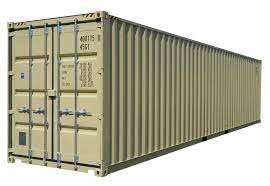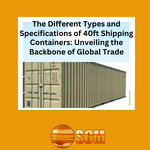Picture a bustling port – stacks of colorful containers, each holding secrets of distant lands. These unassuming steel boxes have transformed commerce, yet their story remains largely untold. Let’s peel back the layers and discover the evolution of 40ft shipping containers.


The Birth of Standardization
Malcolm McLean’s Epiphany
In the mid-20th century, Malcolm McLean, a trucking magnate, gazed at the chaos of cargo handling. He envisioned a world where goods seamlessly transitioned from ship to truck to train. His brainchild? The 40ft shipping container – a game-changer.
The Rise of Dry Containers
- 10ft Container: The smallest sibling, often overlooked. Perfect for lightweight shipments, it moonlights as on-site storage or a cozy home office. Rare but findable on trading platforms.
- 20ft Container: The workhorse of global trade. Easily stackable, quick to load, and ideal for smaller shipments. Think of it as the reliable sedan of containers.
- 40ft Container: When your cargo outgrows the 20ft, this is your go-to. It swallows bulkier goods – machinery, furniture, or even dreams. The backbone of international commerce.
Special Containers: Beyond the Ordinary
- High Cube Containers: These extra-tall cousins add an extra foot (9’6″) to the standard height. Perfect for voluminous cargo or creative minds seeking vertical space.
- Reefer Containers: The cool kids. Insulated and equipped with temperature control, they ferry perishables – think avocados, vaccines, and fine wines.
- Flat Rack Containers: Picture a container doing yoga – collapsible sides, ideal for odd-shaped cargo like boats or heavy machinery.
- Double Door Containers: Like a magician’s box, they open from both ends. Perfect for loading race cars or secrets.
- Open Top Containers: No lid, no limits. Great for loading via crane – think construction materials or oversized sculptures.
- Pallet Wide Containers: A wider embrace – 8’2″ instead of the usual 7’7″. Pallets rejoice!
- Side Door Containers: Unzip the side, load pianos or grand ideas.
- Hard Top Containers: For when you need a rugged roof. Think steel coils or adventure gear.
- Tank Containers: Liquid dreams – chemicals, oils, or exotic elixirs.
- Insulated Containers: Cozy cocoons for temperature-sensitive cargo.
- Half Height Containers: Low-profile warriors – bulk goods, minerals, or superhero costumes.
Key Takeaways
- Efficiency: Standardized containers cut loading time, reduce damage, and keep goods safe.
- Choose Wisely: Match container type to cargo – like pairing wine with cheese.
- Container xChange: Your treasure map. Find containers globally, even when time is scarce.
The Legacy Afloat
Next time you sip Colombian coffee or unbox a Japanese gadget, remember the silent heroes – the 40ft containers that bridge continents. They whisper tales of trade, resilience, and progress. So, as the sun sets over the harbor, salute Malcolm McLean – the visionary who turned metal into magic.


